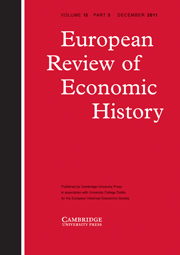Crossref Citations
This article has been cited by the following publications. This list is generated based on data provided by
Crossref.
Gerdrup, Karsten R.
2003.
Three Episodes of Financial Fragility in Norway Since the 1890s.
SSRN Electronic Journal,
Grytten, Ola Honningdal
2003.
Beyond Quantitative and Quanlitative.
Scandinavian Economic History Review,
Vol. 51,
Issue. 2,
p.
23.
Bardsen, Gunnar
Doornik, Jurgen
and
Klovland, Jan Tore T.
2004.
A European-type Wage Equation from an American-style Labor Market: Evidence from a Panel of Norwegian Manufacturing Industries in the 1930s.
SSRN Electronic Journal,
Hunnes, Arngrim
and
Grytten, Ola Honningdal
2009.
Do Prices Reflect Short-Term Output Fluctuations? Empirical Evidence from a Small Open Raw Material Based Economy.
SSRN Electronic Journal,
Grytten, Ola Honningdal
and
Hunnes, Arngrim
2009.
Price Stability and Inflation Persistence During the International Gold Standard: The Scandinavian Case.
SSRN Electronic Journal,
Edvinsson, Rodney
2010.
Major Recessions in Sweden 1850–2000: from pre-capitalist to modern types of crises.
Scandinavian Journal of History,
Vol. 35,
Issue. 4,
p.
403.
Bårdsen, Gunnar
Doornik, Jurgen A.
and
Klovland, Jan Tore
2010.
Wage Formation and Bargaining Power during the Great Depression.
Scandinavian Journal of Economics,
Vol. 112,
Issue. 1,
p.
211.
Grytten, Ola Honningdal
and
Hunnes, Arngrim
2010.
A Chronology of Financial Crises for Norway.
SSRN Electronic Journal,
Mathy, Gabriel P.
and
Meissner, Christopher M.
2011.
Business cycle co-movement: Evidence from the Great Depression.
Journal of Monetary Economics,
Vol. 58,
Issue. 4,
p.
362.
Grytten, Ola Honningdal
2011.
Financial Crises and Monetary Expansion.
SSRN Electronic Journal,
Grytten, Ola Honningdal
and
Hunnes, Arngrim
2012.
The Gold Standard Peripheries.
p.
58.
Abildgren, K.
2012.
Financial structures and the real effects of credit-supply shocks in Denmark 1922-2011.
European Review of Economic History,
Vol. 16,
Issue. 4,
p.
490.
Holmlund, Bertil
2013.
Wage and employment determination in volatile times: Sweden 1913–1939.
Cliometrica,
Vol. 7,
Issue. 2,
p.
131.
Klovland, Jan Tore
2013.
Contributions to a History of Prices in Norway: Monthly Price Indices, 1777-1920.
SSRN Electronic Journal,
Grytten, Ola Honningdal
and
Hunnes, Arngrim
2014.
An anatomy of financial crises in Norway, 1830–2010.
Financial History Review,
Vol. 21,
Issue. 1,
p.
25.
Klovland, Jan Tore
2014.
Challenges for the Construction of Historical Price Indices: The Case of Norway, 1777-1920..
SSRN Electronic Journal,
Klovland, Jan Tore
2016.
Shipping in Dire Straits: New Evidence on Trends and Cycles in Coal Freights from Britain, 1919-1939.
SSRN Electronic Journal ,
Türegün, Adnan
2017.
Revisiting Sweden’s response to the Great Depression of the 1930s: economic policy in a regional context.
Scandinavian Economic History Review,
Vol. 65,
Issue. 2,
p.
127.
Bengtsson, Erik
and
Molinder, Jakob
2017.
The economic effects of the 1920 eight-hour working day reform in Sweden.
Scandinavian Economic History Review,
Vol. 65,
Issue. 2,
p.
149.
Albers, Thilo Nils Hendrik
2018.
The prelude and global impact of the Great Depression: Evidence from a new macroeconomic dataset.
Explorations in Economic History,
Vol. 70,
Issue. ,
p.
150.


